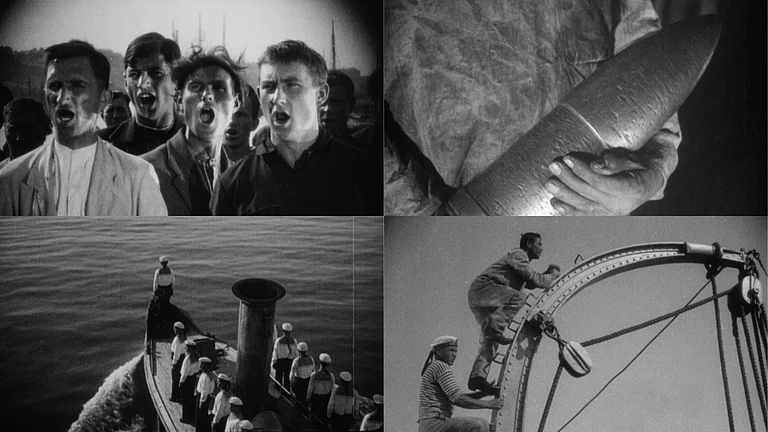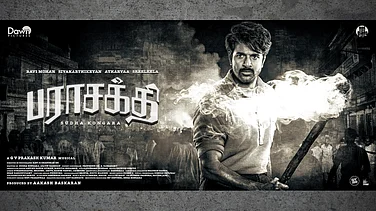Moscow, 1925. In a forlorn theatre, with minimal acoustic support and without any publicity, a film is being exhibited once a day. Inside the theatre, there is hardly an attentive soul. None care for it outside either. Very soon, the film is taken out of theatres, marked to be shelved in the ‘cinema morgue’—a forgotten corner of Sovkino, the institution that bankrolled Soviet Cinema.
Same year. From Berlin to New York, critics and audiences freeze in awe and exasperation. Exactly when did cinema become so visceral? Who taught the young Kiev-born director how to make such eye-popping use of montage? When did this new art become a weapon? Was this history as cinema or was this cinema as history?
Early 40s. The Calcutta Film Society is at its infancy, even if its members include arch film critic Chidananda Dasgupta, and a very tall, and lanky young cinephile, whom his peers would refer to as ‘orient longman’. It was Satyajit Ray. In a dingy, rented room, they decided to show, to a very handful of co-enthusiasts, an avant-garde specimen of cinema that is said to have embodied the Soviet situation, telling its story to the world. But before they could, the local police arrived. Of all films, why this one, they asked? Do you have any plans to trigger a revolution?
The said film, in all three cases, is Sergei Eisenstein’s Battleship Potemkin. In any discussion of cinema’s potency for political mobilisation, it is the urtext. But let’s not draw our conclusions too soon.
***

In the late 1780s, an Irish painter called Robert Barker received a patent to exhibit La nature à coup d’œil (nature at a glance), the grant-document recommending his invention of an entire new contrivance or apparatus. A new contrivance it was, for in 1792, when Barker mounted his first exhibition, the term ‘panorama’—the Greek for ‘pan’ (all)+ ‘horama’ (view)—was pressed into use. That it was coeval with the dismemberment of French Ancien Regime is not an act of serendipity. If the French Revolution, warts and all, had unveiled the era of mass galvanisation in politics, ‘panorama’ heralded the parallel life of mass mobilisation in culture. But how? The panorama was essentially an enlarged, hand-drawn painting of a landscape or city from a vantage or altitude that humans would not normally ascend. Rather than being a specimen of private artistry meant for exclusive access of the state, panoramas were mounted in public. But entrepreneurs soon realised the spectatorial potential of the panorama, and turned it into a site-dependent, ticketed phenomenon.
Soon, panoramas became ever more monumental exercises, keen to play with the viewer’s perspective and tricking him into an illusory experience of being present at the painted site. By 1801, the first purpose-built building to the panorama, the Rotunda at London’s Leicester Square, was inaugurated. Clearly, the panorama was destined to become the first modern site of a designated visual spectacle. Several modifications were added to the static panorama since the 1820s, but none was as important to history as Louis Daguerre’s Diorama. Daguerre created effects with changing illumination, added rudimentary sounds, and made his stage rotate, thereby providing not only ample thrill to the audience but also, as if, making them participate in the manufacture of that thrill. A rudimentary form of ‘mass entertainment’ was hereby born. And that is not all. In the person of Daguerre merged two of 19th century’s most potent techno-visual forms, for in 1839 Daguerre’s Diorama was burned down, and in the same year, he announced the daguerreotype, the earliest form of photography.
Cinema’s birth came hand in hand with tectonic shifts in the global political climate, culminating in the demise of four empires in the Great War of 1914-1918.
Cinema’s origins are usually traced to photography. Technologically, yes. But cinema’s affect has its origins in the panorama. In fact, cinema could be said to be actually born, in the mid-1890s, at the intersection of panorama and photography, when technology mated with immersive illusion and spectacle. From primal forms of mass entertainment, with cinema, we decidedly moved into the era of mass enchantment.
***
The nature of this enchantment and its power of mass influence were not lost to the earliest masters of cinema. Cinema’s birth came hand in hand with tectonic shifts in the global political climate, culminating in the demise of four empires in the Great War of 1914-1918. By then, an adolescent California industry was gaining traction. It became Hollywood in the years that followed, but not before one of its founding figures, D W Griffith, showed the world what cinema could do. His The Birth of a Nation (1915), a three-hour epic spectacle, was unapologetic in its admiration of white supremacy. Griffith made decisive use of cinema to establish the founding ‘untruth’ about the American nation. Enchanted, the world watched.
The 1920s soon followed and we see Fritz Lang’s Die Nibelungen (1924), Sergei Eisenstein’s Strike (1925), and Abel Gance’s Napoleon (1927)—titanic achievements that were tied, irrevocably, to a nation’s will, pride and weight. The climax of this kind of “great-cinema-as-propaganda,” was Leni Riefenstahl’s Triumph of Will (1934) and Olympia (1936), visionary artistic enterprises in the service of Nazism. But if one looks deeper, the reception of cinema as a political vehicle goes deeper. Charlie Chaplin’s The Great Dictator (1940)—his provocatively pacifist, supremely satirical, anti-Nazi tour-de-force—was deemed as propaganda against Germany’s self-will. Orson Welles lost his seat forever in Hollywood when his pioneering Citizen Kane (1941) was perceived as a poetic yet pointed polemic against the apparent impunity of the ‘American dream’. If the escapist Hollywood musicals provided that impunity during the years of WWII, they were followed by the Cold War, where space-science became the site of competitive national egotism, much of which became actualised in science fiction cinema. There were also the US-made war movies—film after film—in which Nazis were reduced to cardboards. Then the Rambo franchise started to appear as the US sought to avenge the humiliation of Vietnam and Afghanistan through cinema, now increasingly very poorly conceived.
***
It may seem that political cinema is interchangeable with propaganda. But from where we stand, it is not, for we must caution ourselves about using the word ‘propaganda’ too loosely. Both political and propaganda cinema are aimed at the broad philosophy of mass mobilisation that has been so organic to cinema’s origins. But there are two simple differences. First, just like good adaptations are never the faithful ones, powerful political cinema would never dress itself as propaganda. Second, unlike political cinema, propaganda is almost always aimed at defaming in fiction what cannot be countered by fact. If we call it the ‘Rambo Complex’, it is exactly what the current crop of kitschy Hindi propaganda cinema, brazenly uncouth in its claims, is to be seen as.
But most importantly, cinema’s real potency to harness the power of enchantment might want to militate against its use as a servile, conformist propaganda vehicle. And to know why, we may want to turn again to Eisenstein. After his initial triumph, Eisenstein came to be considered too much of a formalist and was dropped from even the slightest state benevolence. He was recalled more than a decade later for Alexander Nevsky (1938), a braggadocio of a period film about Russia’s founding figure. Happy with the outcome, Stalin gave him Ivan the Terrible, whom the canny dictator saw as a historical mirror—as a misunderstood autocrat who had to take uneasy decisions for the sake of his nation. Originally planned as a trilogy, the first part was thunderously approved, and enthusiastically received. But in the second part, somewhat relieved of typical Soviet surveillance, Eisenstein portrayed a bloodthirsty, unhinged, paranoid tyrant, for whom torture was music, murder was banal, and power was opium. His fate was sealed forever. In two years, Eisenstein died of a failed heart, but not before he could tell the world that if the enchantment of Battleship Potemkin could start a revolution, that of Ivan the Terrible could as well bring it to an end.
(Views expressed are personal)
(This appeared in the print as 'The Spectre Of Eisenstein')
MORE FROM THIS ISSUE
Sayandeb Chowdhury teaches literature and cinema at Krea University, Andhra Pradesh






























